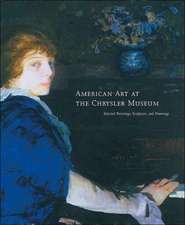Women, Femininity and Public Space in European Visual Culture, 1789-1914
Editat de Temma Balducci, Heather Belnap Jensenen Limba Engleză Paperback – 14 iun 2017
| Toate formatele și edițiile | Preț | Express |
|---|---|---|
| Paperback (1) | 436.14 lei 6-8 săpt. | |
| Taylor & Francis – 14 iun 2017 | 436.14 lei 6-8 săpt. | |
| Hardback (1) | 770.81 lei 6-8 săpt. | |
| Taylor & Francis – 4 noi 2014 | 770.81 lei 6-8 săpt. |
Preț: 436.14 lei
Nou
Puncte Express: 654
Preț estimativ în valută:
83.47€ • 86.82$ • 68.91£
83.47€ • 86.82$ • 68.91£
Carte tipărită la comandă
Livrare economică 14-28 aprilie
Preluare comenzi: 021 569.72.76
Specificații
ISBN-13: 9781138310179
ISBN-10: 1138310174
Pagini: 356
Ilustrații: 63
Dimensiuni: 174 x 246 x 19 mm
Greutate: 0.45 kg
Ediția:1
Editura: Taylor & Francis
Colecția Routledge
Locul publicării:Oxford, United Kingdom
ISBN-10: 1138310174
Pagini: 356
Ilustrații: 63
Dimensiuni: 174 x 246 x 19 mm
Greutate: 0.45 kg
Ediția:1
Editura: Taylor & Francis
Colecția Routledge
Locul publicării:Oxford, United Kingdom
Cuprins
Contents: Introduction, Temma Balducci and Heather Belnap Jensen; Marketing the maternal body in the public spaces of post-Revolutionary Paris, Heather Belnap Jensen; Baroness Hyde de Neuville and the sidewalks of New York, 1807-14, Laura Auricchio; Mediating private and public: Juliette Récamier’s salon at L’Abbaye-aux-Bois, Daniel Harkett; The female artist in the public eye: women copyists at the Uffizi, 1770-1859, Sheila Barker; A woman abroad: Emma Brownlow in Brittany, Pamela Gerrish Nunn; Representing the modern woman: the fashion plate reconsidered (1865-75), Justine De Young; ‘Excessive Industry’: female art historians, popular publishing and professional access, Amy M. von Lintel; Connaisseuses and cocottes: women at the Salon in French caricature, Karen J. Leader; Aller à pied: bourgeois women on the streets of Paris, Temma Balducci; De paseo: tracing women’s steps in Madrid’s late 19th-century illustrated press, Vanesa Rodríguez-Galindo; Women, art history and the public sphere: Emilia Dilke’s 18th century, Elizabeth C. Mansfield; Walking the dog à la ville: Louise Abbéma, women and the Parisian landscape, Miranda Mason; The boarders and borders of Emily Carr’s London Student Sojourn, Samantha Burton; Separation and erasure: the fate of women artists in Vienna, Julie M. Johnson; Single women, public space and the German Ledigenheim, Erin Eckhold Sassin; Gertrude Stein ‘facing both ways’, Annalisa Zox-Weaver; Selected bibliography; Index.
Notă biografică
Temma Balducci is Associate Professor of Art History at Arkansas State University, USA. Her research focuses on the intersection of gender and visual culture in nineteenth-century French art and in feminist art of the 1970s. Heather Belnap Jensen is Associate Professor of Art History & Curatorial Studies and Women's Studies Faculty Affiliate at Brigham Young University, USA. Jensen specializes in women in post-Revolutionary French culture.
Recenzii
'This collection of essays presents important new research that challenges the traditional binary of public and private and reframes conventional interpretations of gendered space. The authors promote a more complex understanding of empowered female subjectivity and agency in Western Europe and North America in the long nineteenth century. The detailed and theoretically rigorous studies demonstrate the important roles of women in both shaping and enacting modernity as public maternal figures, artists, collectors, art historians, pedestrians, travelers and consumers of art and fashion.' Alison McQueen, McMaster University, Canada
Descriere
Focusing on images of or produced by nineteenth-century European women, this volume explores genteel femininity as resistant to easy codification vis-Ã -vis the public. Attending to various iterations of the public as space, sphere and discourse, sixteen essays challenge the false binary construct that has held the public as the sole preserve of prosperous men. By considering works in a range of media by an array of canonical and understudied women artists, they demonstrate that definitions of both femininity and the public were mutually defining and constantly shifting.











